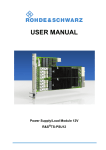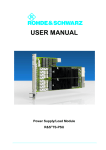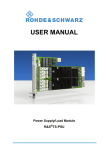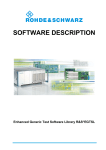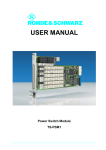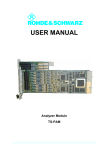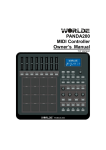Download USER MANUAL - Rohde & Schwarz
Transcript
USER MANUAL Multiplex/Switch Module 2 R&S®TS-PSM2 User Manual for ROHDE & SCHWARZ Multiplex/Switch Module R&S TS-PSM2 2nd Issue / 08.06 / GB 1504.4799.12 All rights, also translation into foreign languages, are reserved. No part of this manual is permitted to be reproduced in any form (print, photocopy or any other method), also not for the preparation of lectures, or processed, reproduced or made available using electronic systems without written permission from ROHDE & SCHWARZ. ® The passing on to third parties and the reproduction of this documentation, utilisation and communication of its contents is not permitted unless specifically approved. Infringements will incur claims for damages. All rights reserved in the case of the award of a patent or registration of a design. R&S® is a registered trademark of ROHDE & SCHWARZ GmbH & Co. KG. We draw to your attention that the names of software and hardware used in the Service Manual, and the brand names of the respective companies are, in general, the subject of protection as trademarks, or under proprietary rights, or patent law. ROHDE & SCHWARZ GmbH & Co. KG Corporate Headquarters Mühldorfstr. 15 D-81671 München Telephone: Fax: ...49 (0)89/4129-13774 ...49 (0)89/4129-13777 Printed in the Federal Republic of Germany. Errors excepted, subject to technical change without notice. Safety Instructions Attention! Electrostatic sensitive devices require special care Support Center Telephone Europe: +49 180 512 42 42 Telephone worldwide: +49 89 4129 13774 Fax: +49 89 4129 13777 e-mail: [email protected] If you have any technical queries about this Rohde & Schwarz equipment, our Hotline at the Support Center of Rohde & Schwarz Sales-GmbH will be glad to help. Our team will discuss your queries and look for solutions to your problems. The Hotline is open Mondays to Fridays from 08.00 to 17.00 hrs. For queries outside office hours, you can leave a message or send a note via fax or email. We will then get back to you as soon as possible. Multiplex/Switch Module R&S TS-PSM2 Contents Contents 1 Usage 1-1 1.1 General 1-1 1.2 Safety instructions 1-1 1.3 Characteristics 1-2 2 View 2-1 3 Block Diagrams 3-1 4 Layout 4-1 4.1 Mechanical layout 4-1 4.2 Display elements 4-2 Function Description 5-1 5.1 Signal concept 5-1 5.2 System functions 5-1 5.3 Flexibility 5-2 5.4 Compactness 5-3 5.5 Interference immunity 5-3 5.6 Sample applications 5-4 5.6.1 Simple switching function - normally open, 1-pin. 5-4 5.6.2 Simple switching function - changeover contact, 1-pin. 5-4 5.6.3 Current measurement - indirect, via shunt resistor 5-5 5.6.4 Current measurement - direct, up to 1 A 5-5 5.6.5 Multiplexer - test object signals 5-6 5.6.6 Multiplexer - CompactPCI/PXI instruments 5-7 5.6.7 Multiplexer - external components, up to 1 A 5-8 5 2nd Issue 08.06 6 7 Commissioning 6-1 6.1 Installation of the plug-in module 6-1 6.2 Initialisation of the plug-in module 6-1 6.3 Instructions for operation with voltages dangerous to the touch 6-2 Software 7-1 7.1 7-1 Driver software 3 Contents 8 9 Multiplex/Switch Module R&S TS-PSM2 7.2 Softpanel 7-2 7.3 Sample programme 7-3 7.3.1 Programming with GTSL libraries 7-3 7.3.2 Programming with device drivers 7-5 Self-Test 8-1 8.1 LED test 8-1 8.2 Power on test 8-1 8.3 TSVP self-test 8-2 Interface description 9-1 9.1 Connector X1 9-1 9.2 Connector X4 9-2 9.3 Connector X5 9-2 9.4 Connector X10 9-3 9.5 Connector X20 9-5 9.6 Connector X30 9-6 9.7 Connector X40 9-7 9.8 Connector X50 9-9 10-1 2nd Issue 08.06 10 Specifications 4 Multiplex/Switch Module R&S TS-PSM2 Figures Figures View of the R&S TS-PSM2.................................................................2-1 Figure 3-1 Functional block diagram R&S TS-PSM2 ........................................3-1 Figure 3-2 Detailed block diagram R&S TS-PSM2 ............................................3-2 Figure 4-1 Arrangement of connectors and LEDs ............................................4-1 Figure 5-1 Switching group.................................................................................5-2 Figure 5-2 Simple switching function - normally open, 1-pin..........................5-4 Figure 5-3 Simple switching function - changeover contact, 1-pin. ...............5-4 Figure 5-4 Current measurement - indirect, via shunt resistor .......................5-5 Figure 5-5 Current measurement - direct, up to 1 A .........................................5-5 Figure 5-6 Multiplexer - test object signals ......................................................5-6 Figure 5-7 Multiplexer - CompactPCI/PXI instruments.....................................5-7 Figure 5-8 Multiplexer - external components, up to 1 A .................................5-8 Figure 6-1 Permissible voltages on analog bus lines ......................................6-2 Figure 7-1 Softpanel R&S TS-PSM2 ...................................................................7-2 Figure 9-1 Connector X1 (view: mating side) ....................................................9-1 Figure 9-2 Connector X4 (view: mating side) ....................................................9-2 Figure 9-3 Connector X5 (view: mating side) ....................................................9-2 Figure 9-4 Connector X10 (view: mating side) ..................................................9-3 Figure 9-5 Connector X20 (view: mating side) ..................................................9-5 Figure 9-6 Connector X30 (view: mating side) ..................................................9-6 Figure 9-7 Connector X40 (view: mating side) ..................................................9-7 Figure 9-8 Connector X50 (view: mating side) ..................................................9-9 2nd Issue 08.06 Figure 2-1 5 Multiplex/Switch Module R&S TS-PSM2 2nd Issue 08.06 Figures 6 Multiplex/Switch Module R&S TS-PSM2 Tables Tables Characteristics R&S TS-PSM2..........................................................1-2 Table 4-1 Connector on the R&S TS-PSM2......................................................4-2 Table 4-2 Display elements on the R&S TS-PSM2 ..........................................4-2 Table 7-1 Driver installation R&S TS-PSM2 .....................................................7-1 Table 8-1 Observations about the LED test .....................................................8-1 Table 8-2 Observations about the power on test ............................................8-1 Table 9-1 Assignment of X1 ..............................................................................9-1 Table 9-2 Assignment of X4 ..............................................................................9-2 Table 9-3 Assignment of X5 ..............................................................................9-2 Table 9-4 Assignment of X10 ............................................................................9-3 Table 9-5 Assignment of X20 ............................................................................9-5 Table 9-6 Assignment of X30 ............................................................................9-6 Table 9-7 Assignment of X40 ............................................................................9-7 Table 9-8 Assignment of X50 ............................................................................9-9 2nd Issue 08.06 Table 1-1 7 Multiplex/Switch Module R&S TS-PSM2 2nd Issue 08.06 Tables 8 Multiplex/Switch Module R&S TS-PSM2 Usage 1 Usage 1.1 General The ROHDE & SCHWARZ Multiplex/Switch Module R&S TS-PSM2 is designed for switching or distribution of signals of medium output up to 125 VDC or currents up to 2 ADC. The R&S analog bus can be used to measure voltages and currents on all circuit nodes. These functions are especially important if current must be measured for the test object in normal operation and in addition a measurement must be performed in standby mode. In addition to the functionality of a simple power switching module, small signals can be switched in the lower MHz range with high quality. The R&S TS-PSM2 can be used in the R&S CompactTSVP and R&S PowerTSVP (TSVP = Test System Versatile Platform). It is inserted into the front of the TSVP housing. The 96-pin connector connects flush with the TSVP. It is used to establish contact with test objects. If necessary, an additional adapter frame can be used. The R&S TS-PSM2 is connected on the rear of the CAN/PXI bus and on the analog bus of the TSVP backplane. The side connector and the system connector allow for project-specific extensions. 1.2 Safety instructions WARNING! 2nd Issue 08.06 In order to prevent danger to users when voltages dangerous to the touch are in use, the Test System Versatile Platform R&S CompactTSVP TS-PCA3 and R&S PowerTSVP TS-PWA3 should never be operated with the housing open or with the front and back panels open. General safety regulations must be observed. 1-1 Usage Multiplex/Switch Module R&S TS-PSM2 CAUTION! If signals with voltages dangerous to the touch are being transferred via the analog bus, all modules involved, including PXImodules from other suppliers, must be specified for the relevant voltage. For additional information on operation with voltages dangerous to the touch, see Section 6.3. 1.3 Characteristics Characteristics R&S TS-PSM2 Switching module for power supplies and loads with medium power. Switching of voltages up to 125 V Switching of currents up to 2 A 8 relay groups, each with: 1 Multiplexer 4:1, two-pin, DPST or 1 change-over contact, one-pin, SPDT with shunt resistor 3 make contacts, one-pin, SPST with shunt resistor 1 make contact, two-pin, DPDT to local Powerbus/side plug connector Indirect current measurement via shunt resistors Direct current measurement via R&S analog bus and plug-in module R&S TS-PSAM (<1 A) Self-test of all relays via analog bus and plug-in module R&S TS-PSAM Control bus: CAN Table 1-1 Characteristics R&S TS-PSM2 1-2 2nd Issue 08.06 For use in R&S CompactTSVP and R&S PowerTSVP Multiplex/Switch Module R&S TS-PSM2 View 2 View Figure 2-1 shows the view of the Multiplex/Switch Module R&S TS-PSM2. 2nd Issue 08.06 Figure 2-1 View of the R&S TS-PSM2 2-1 Multiplex/Switch Module R&S TS-PSM2 2nd Issue 08.06 View 2-2 Multiplex/Switch Module R&S TS-PSM2 Block Diagrams 3 Block Diagrams Figure 3-1 and Figure 3-2 shows the functional block diagram and the block diagram of the Multiplex/Switch Module R&S TS-PSM2. TS-PSM2 Analog Bus (AB) Analog Bus X30 Coupling Relais CHANNEL 3 CHANNEL 4 CHANNEL 5 CHANNEL 6 CHANNEL 7 LABA1...LABD2 CHANNEL 8 RAM PXI Trigger Logic SPI System Connector X50 Side Connector X40 Microcontroller Extension ConnectorX1 X20 cPCI Connector CHANNEL 2 Front Connector X10 CHANNEL 1 Extension Connector X20 Local Analog Bus (LAB) GND Local Power Bus A Local Power Bus B 2nd Issue 08.06 Figure 3-1 Functional block diagram R&S TS-PSM2 3-1 Extension Connector X1 X20 cPCI Connector Extension Connector X20 Microcontroller 2nd Issue 08.06 SPI PXI Trigger Logic System Connector X50 3-2 Figure 3-2 Detailed block diagram R&S TS-PSM2 Side Connector X40 Analog Bus X30 Local Analog Bus Front Connector X10 Block Diagrams Multiplex/Switch Module R&S TS-PSM2 Multiplex/Switch Module R&S TS-PSM2 Layout 4 Layout 4.1 Mechanical layout The Multiplex/Switch Module R&S TS-PSM2 is designed as a long plug-in card for front installation in the TSVP housing. The installation depth is 300 mm. The front panel has 4 height units. X1/X20 connectors are used to make connections to the cPCI backplane of the R&S CompactTSVP; X20 connector is used for connections to the control backplane of the R&S PowerTSVP. The X30 connector connects the R&S TS-PSM2 with the analog bus backplane in the TSVP housing. The test object and peripheral devices are connected to the X10 connection on the front. The X40 side connector and the X50 system connector can be used project-specifically. The X4 and X5 connectors are used for internal purposes. 7 COM PWR X30 1 1 X20 X40 X10 1 X4 X1 X50 32 7 8 X5 1 2 1 2nd Issue 08.06 Figure 4-1 Arrangement of connectors and LEDs 4-1 Layout Multiplex/Switch Module R&S TS-PSM2 Abbreviation Use X1 cPCI Connector X4 Clock Configuration X5 RS232 Interface X10 Front Connector X20 PXI/Extension Connector X30 Analog Bus Connector X40 Side Connector X50 System Connector Table 4-1 Connector on the R&S TS-PSM2 4.2 Display elements (see Figure 4-1) There are three light diodes (LEDs) on the front of the R&S TS-PSM2 with the following functions: LED Description ERR (red) Error: Lit if an error is discovered after the system is turned on during the startup test on the R&S TS-PSM2 . COM (yellow) Communication: Lit briefly to indicate access to the R&S TS-PSM2 via the interface. PWR (green) Power supply voltage: Lit if all power supply voltages are present. 2nd Issue 08.06 Table 4-2 Display elements on the R&S TS-PSM2 4-2 Multiplex/Switch Module R&S TS-PSM2 Function Description 5 Function Description (see Chapter 3, Functional block diagram) 5.1 Signal concept The design and construction of the Multiplex/Switch Module R&S TS-PSM2 guarantee excellent guiding of load and measurement paths. Both „Force“ channels with high currents as well as „Sense“ channels of voltage and current sources or loads are guided to the test object via the R&S TS-PSM2. In the opposite direction, test objects can be switched with single- or multi-pin loads. Eight two-pin 4-to-1 multiplexers make it possible to select from four measurement signals. These signals can be configured via local power buses (LPBA and LPBB) to larger multiplexers or can be applied to GND. Access to the R&S analog bus makes it possible to connect all input channels with measurement and stimulus modules of the R&S CompactTSVP without the need for any additional external wiring. In order to facilitate measurements of high currents without voltage drops interfering, low-Ohm shunt resisters (22 mΩ) are inserted into each channel. The instantaneous current can be measured indirectly through these shunt resisters as a voltage value. All channels are shielded in a low-Ohm design. This reduces voltage drops and crosstalk. 5.2 System functions The system functions are implemented by a local processor with internal Flash. There is also an external SRAM. Communication with the system controller in the R&S CompactTSVP is via the CAN bus. 2nd Issue 08.06 The functions of the R&S TS-PSM2 may be summarised as follows: • Analog function test • Switching voltage/current sources • Switching test object loads (original loads, simulated/electronic loads) • Power Multiplexer • Switch simulation 5-1 Function Description Multiplex/Switch Module R&S TS-PSM2 5.3 Flexibility The structure of the R&S TS-PSM2 in addition to the wide voltage and current range, combined with effective use extending into the lower MHz range, guarantee a high level of flexibility and a wide range of uses. Even complex yet flexible load systems with original loads and/or electronic loads can be implemented using multiple module-internal connections. Figure 5-1 shows the basic principle with a switching group consisting of four switching elements. Detail implementation with two changeover contacts offers advantages for sensed current measurements because the contact resistance of the relay is not introduced as an error. There is no need to take this into consideration in the function. LABx1 LABx2 Local Analog Bus CHx_HI1 CHx_HI CHx_HI1 CHx_LO1 Front Connector X10 CHx_LO1 CHx_LO CHx_HI2 CHx_LO2 CHx_HI3 CHx_LO3 CHx_HI4 CHx_LO4 CHx_HI CHx_LO Side Connector This switching group is present eight times on the R&S TS-PSM2 module. Four input channels each can be switched with two pins to a separate Mux bus. In addition, each bus can be switched to the local analog bus LABxx (max. 1 A), the local Powerbus LPBx or the side connector. Input channels with R&S CompactTSVP measuring system and PXI 5-2 2nd Issue 08.06 Figure 5-1 Switching group Multiplex/Switch Module R&S TS-PSM2 Function Description measuring system can be connected via the R&S analog bus. The local analog bus is also directed to connector X20. Signals can also be connected here from the back of the R&S CompactTSVP through corresponding rear I/O modules. The local Powerbus lines are accessible on side connector X40. In this case standard PXI modules, which typically do not have a relay multiplexer, can have access to the multiplexers or the R&S analog bus via flat-band cable on the side. Another application consists of integrating project-specific additions via the side and system connector X50 (for example passive loads, terminating resistors, voltage distributors, etc.). 5.4 Compactness The layout of the R&S TS-PSM2 (one slot) with 112 relays offers maximum space savings. Extremely high-powered and compact measurement and load systems can be set up with as many as 12 modules in the R&S CompactTSVP and 16 modules in R&S PowerTSVP. These measurement and load systems can be integrated directly into manufacturing cells, which makes them very cost-efficient. 5.5 Interference immunity 2nd Issue 08.06 Optimal behaviour regarding electrical interference or temperature increases is achieved by control through the serial differential CAN bus (Controller Area Network). 5-3 Function Description Multiplex/Switch Module R&S TS-PSM2 5.6 Sample applications 5.6.1 Simple switching function - normally open, 1-pin. The relay switches the channel on and off; the shunt resistor is not used. CHx_HI2...4 Figure 5-2 Simple switching function - normally open, 1-pin 5.6.2 Simple switching function - changeover contact, 1-pin. The relay switches the channel; the shunt resistor is not used. CHx_HI1 CHx_LO1 2nd Issue 08.06 Figure 5-3 Simple switching function - changeover contact, 1-pin. 5-4 Multiplex/Switch Module R&S TS-PSM2 Function Description 5.6.3 Current measurement - indirect, via shunt resistor The circuit is closed or opened through the relay. The voltage drop on the shunt resistor is measured with a voltmeter via the R&S analog bus. The current can be calculated from the voltage and the value of the shunt. The second relay contact is used to eliminate the measurement error caused by the resistance of the switching contact. CHx_HI1...4 Figure 5-4 Current measurement - indirect, via shunt resistor 5.6.4 Current measurement - direct, up to 1 A The current is measured directly with a current measurement device via the analog bus. CHx_HI1...4 2nd Issue 08.06 Figure 5-5 Current measurement - direct, up to 1 A 5-5 Function Description Multiplex/Switch Module R&S TS-PSM2 5.6.5 Multiplexer - test object signals Up to four test object signals can be multiplexed to a single local bus. If necessary, the local bus can be connected with up to three additional local buses or with the global R&S analog bus. CH1_HI1 CH1_LO1 Local Analog Bus/ Analog Bus CH1_HI2 CH1_LO2 CH1_HI3 CH1_LO3 CH1_HI4 CH1_LO4 CH1_HI 2nd Issue 08.06 Figure 5-6 Multiplexer - test object signals 5-6 Multiplex/Switch Module R&S TS-PSM2 Function Description 5.6.6 Multiplexer - CompactPCI/PXI instruments Signals of adjacent CompactPCI/PXI modules can be directed to the local multiplex bus via the side connector and a two-pin changeover contact. Routing to the global R&S analog bus is also possible. CH1_HI1 CH1_LO1 Local Analog Bus/ Analog Bus CH1_HI2 CH1_LO2 CH1_HI3 CH1_LO3 CH1_HI4 CH1_LO4 CH1_HI Side Connector Cable 2nd Issue 08.06 Figure 5-7 Multiplexer - CompactPCI/PXI instruments 5-7 Function Description Multiplex/Switch Module R&S TS-PSM2 5.6.7 Multiplexer - external components, up to 1 A Signals of external components can be directed to the local multiplexer bus via the local R&S analog bus and an optional customer-specific rear I/O module. Routing to the global R&S analog bus is also possible. Backplane Connector RIO Connector RIO Module CH1_HI1 External Instrument Cable Local Analog Bus CH1_LO1 CH1_HI2 CH1_LO2 CH1_HI3 CH1_LO3 CH1_HI4 CH1_LO4 CH1_HI 2nd Issue 08.06 Figure 5-8 Multiplexer - external components, up to 1 A 5-8 Multiplex/Switch Module R&S TS-PSM2 Commissioning 6 Commissioning 6.1 Installation of the plug-in module To install the Multiplex/Switch Module R&S TS-PSM2 , proceed as follows: • Shut down the TSVP and turn it off. • Select a suitable front plug-in slot. • Loosen the screws and remove the appropriate front plate section on the TSVP housing. CAUTION! Check the backplane connectors for bent pins! Any pins that are bent must be straightened! Failure to observe this instruction may result in permanent damage to the backplane! • Applying moderate pressure, insert the plug-in module • The upper catch pin of the plug-in module must be guided into the right hole, while the lower one is guided into the left hole on the TSVP housing CAUTION! When inserting the plug-in module, use both hands to guide it and carefully press it into the backplane connectors. • When the plug-in module is correctly inserted, you will feel it reach a definite mechanical limit • Tighten the upper and lower screws on the front plate of the plugin module. 2nd Issue 08.06 6.2 Initialisation of the plug-in module After the system is booted, the R&S TS-PSM2 is initialised. Signals GA0 ... GA5 on the cPCI bus are used for slot identification. 6-1 Commissioning Multiplex/Switch Module R&S TS-PSM2 6.3 Instructions for operation with voltages dangerous to the touch In conformity with EN 61010-1, the following voltage limit values are considered „dangerous and active“. • 70 V DC • 33 V AC eff • 46.7 V AC peak WARNING! When operating the Multiplex/Switch Module R&S TS-PSM2 above these voltage limit values, the requirements of EN61010-1 must be observed. The Multiplex/Switch Module R&S TS-PSM2 and Test System Versatile Platform R&S CompactTSVP are designed for a maximum voltage of 125 V between ground-free measurement devices, analog buses and GND. Care must be taken to ensure that this limit is not exceeded at any time, even as the sum of voltages, and thus not as a results of alternating signals. Figure 6-1 shows a typical permissible voltage configuration between analog buses and ground. 0...125 V Analog bus 0...125 V - 125 V 5V 125 V 125 V max 125 V max 125 V max floating 125 V max!! 125 V max!! 0...125 V 125 V max!! 120 V 125 V max!! 125 V GND referenced signals Figure 6-1 Permissible voltages on analog bus lines 2nd Issue 08.06 For reasons of fire prevention in conformity with EN 61010-1, we recommend limiting the current or output for DC sources to 150 VA. 6-2 Multiplex/Switch Module R&S TS-PSM2 Software 7 Software 7.1 Driver software A LabWindows IVI driver is available to control the Multiplex/Switch Module R&S TS-PSM2 that supports class IVI SWTCH. All additional functions of the hardware are supported by specific extensions of the driver. The driver is a component of the ROHDE & SCHWARZ GTSL software. All functions of the driver are documented extensively in online Help and in the LabWindows/CVI Function Panels. The following software modules are installed during driver installation: Module Path Note rspsm2.dll <GTSL directory>\Bin Driver rspsm2.hlp <GTSL directory>\Bin Help file rspsm2.fp <GTSL directory>\Bin LabWindows CVI Function Panel File, Function Panels for CVI Development Environment rspsm2.sub <GTSL directory>\Bin LabWindows CVI attribute file. This file is required by several„Function Panels“. rspsm2.lib <GTSL directory>\Bin Import library rspsm2.h <GTSL directory>\Include Header file for driver Table 7-1 Driver installation R&S TS-PSM2 NOTE: 2nd Issue 08.06 The IVI and VISA library of National Instruments are required to operate the driver. 7-1 Software Multiplex/Switch Module R&S TS-PSM2 7.2 Softpanel Figure 7-1 Softpanel R&S TS-PSM2 7-2 2nd Issue 08.06 A "Soft-Panel" is included with the software package for R&S TS-PSM2 (see Figure 7-1). The Soft-Panel requires the support of the IVI driver. It makes it possible to operate the module interactively pointing on the screen and clicking with the mouse. Multiplex/Switch Module R&S TS-PSM2 Software 7.3 Sample programme 7.3.1 Programming with GTSL libraries /* This example connects TS-PSM2 channel 1 to different internal and external switch channels. Error handling is not considered in this sample in order to keep it easy to read. The return status should be checked for "errorOccured" after each library call. The following configuration files are used in this example: physical.ini -----------[device->psm2_7] Description = "TS-PSM2, Slot 7" Type = PSM2 ResourceDesc = CAN0::0::2::7 DriverDll = rspsm2.dll DriverPrefix = rspsm2 DriverOption = "Simulate=0,RangeCheck=1" ; the analog bus pseudo device is used by the switch manager [device->abus] Type = AB Psm2Application.ini ------------------[bench->switch] ; configure the SwitchDevice1 = AnalogBus = AppChannelTable TS-PSM2 as switch device device->psm2_7 device->abus = io_channel->switch 2nd Issue 08.06 ; configure the switch channels [io_channel->switch] ; TS-PSM2 channels CH1 = psm2_7!CH1 CH1_1 = psm2_7!CH1_1 CH1_HI = psm2_7!CH1_HI CH1_LO = psm2_7!CH1_LO ; TS-PSM2 local power bus LPBA = psm2_7!LPBA 7-3 Software Multiplex/Switch Module R&S TS-PSM2 ; TS-PSM2 local analog bus LABa1 = psm2_7!LABa1 LABa2 = psm2_7!LABa2 ; TSVP system wide analog bus ABa1 = abus!ABa1 ABa2 = abus!ABa2 */ #include "resmgr.h" #include "swmgr.h" int main (int argc, char *argv[]) { long residSwmgr; /* resource ID for switch manager library */ short errorOccurred = 0; long errorCode = 0; char errorMessage [GTSL_ERROR_BUFFER_SIZE] = ""; /* load the physical and application configuration files */ RESMGR_Setup ( 0, "physical.ini", "Psm2Application.ini", &errorOccurred, &errorCode, errorMessage); /* initialize the switch manager library */ SWMGR_Setup ( 0, "bench->switch", &residSwmgr, &errorOccurred, &errorCode, errorMessage); /* connect channel 1 to local power bus A */ SWMGR_Connect ( 0, residSwmgr, "CH1", "LPBA", &errorOccurred, &errorCode, errorMessage); /* connect channel 1 to local front connector */ SWMGR_Connect ( 0, residSwmgr, "CH1", "CH1_1", &errorOccurred, &errorCode, errorMessage); /* connect local analog bus lines to analog bus line on backplane */ SWMGR_Connect ( 0, residSwmgr, "LABa1", "ABa1", &errorOccurred, &errorCode, errorMessage); SWMGR_Connect ( 0, residSwmgr, "LABa2", "ABa2", &errorOccurred, &errorCode, errorMessage); /* wait until relays have settled; timeout 500 SWMGR_WaitForDebounce ( 0, residSwmgr, 500, 7-4 ms */ 2nd Issue 08.06 /* connect channel 1 to local analog bus lines */ SWMGR_Connect ( 0, residSwmgr, "CH1_HI", "LABa1", &errorOccurred, &errorCode, errorMessage); SWMGR_Connect ( 0, residSwmgr, "CH1_LO", "LABa2", &errorOccurred, &errorCode, errorMessage); Multiplex/Switch Module R&S TS-PSM2 &errorOccurred, &errorCode, Software errorMessage); /* disconnect channel 1 from local front connector */ SWMGR_Disconnect ( 0, residSwmgr, "CH1", "CH1_1", &errorOccurred, &errorCode, errorMessage); /* wait until relays have settled; timeout 500 SWMGR_WaitForDebounce ( 0, residSwmgr, 500, &errorOccurred, &errorCode, errorMessage); ms */ /* disconnect the rest */ SWMGR_DisconnectAll ( 0, residSwmgr, &errorOccurred, &errorCode, errorMessage); /* close the library */ SWMGR_Cleanup ( 0, residSwmgr, &errorOccurred, &errorCode, errorMessage); RESMGR_Cleanup ( 0, &errorOccurred, &errorCode, errorMessage); return 0; } 7.3.2 Programming with device drivers /* Error handling is not considered in this sample in order to keep it easy to read. The return status should be checked for VI_SUCCESS after each driver call. */ #include "rspsm2.h" 2nd Issue 08.06 int main (int argc, char *argv[]) { ViSession vi; ViStatus status; /* open a session to the device driver. The resource descriptor depends on the slot number of the module and must be adapted to the target system. */ status = rspsm2_InitWithOptions ("CAN0::0::2::7::INSTR", VI_TRUE, VI_TRUE, "Simulate=0,RangeCheck=1", &vi); /* connect channel 1 to Local Power Bus A */ status = rspsm2_Connect (vi, "CH1", "LPBA"); 7-5 Software Multiplex/Switch Module R&S TS-PSM2 /* connect channel 1 to front connector */ status = rspsm2_Connect (vi, "CH1", "CH1_1"); /* connect channel 1 HI to local analog bus line */ status = rspsm2_Connect (vi, "CH1_HI", "LABa1"); /* connect channel 1 LO to local analog bus line */ status = rspsm2_Connect (vi, "CH1_LO", "LABa2"); /* connect local analog bus line to analog bus status = rspsm2_Connect (vi, "ABa1", "LABa1"); line on back plane */ /* connect local analog bus line to analog bus status = rspsm2_Connect (vi, "ABa2", "LABa2"); line on back plane */ /* wait until relays have settled; timeout 500 status = rspsm2_WaitForDebounce (vi, 500.0); ms */ /* disconnect channel 1 from front connector */ status = rspsm2_Disconnect (vi, "CH1", "CH1_1"); /* wait until relay has settled; timeout 500 status = rspsm2_WaitForDebounce (vi, 500.0); ms */ /* disconnect the rest */ status = rspsm2_DisconnectAll(vi); /* close the driver session */ status = rspsm2_close (vi); 2nd Issue 08.06 return 0; } 7-6 Multiplex/Switch Module R&S TS-PSM2 Self-Test 8 Self-Test The Multiplex/Switch Module R&S TS-PSM2 has an integrated capability for self-test. The following tests are possible: • LED test • Power on test • TSVP self-test 8.1 LED test After the system is turned on, all three LEDs are lit for about three seconds. This indicates that the 5-V power supply has been applied; all LEDs are in proper order. The following observations may be made about different display states: LED Description One individual LED is not lit Hardware problem in the module All LEDs are not lit +5 V power supply voltage missing Table 8-1 Observations about the LED test 8.2 Power on test The power on test runs in parallel to the LED test. The following observations may be made about the different display states of the LEDs. 2nd Issue 08.06 LED Description PWR LED (green) on Power supply voltage present PWR LED (green) off Power supply voltage missing ERR LED (red) off No error is present Table 8-2 Observations about the power on test 8-1 Self-Test Multiplex/Switch Module R&S TS-PSM2 LED ERR LED (red) Is lit or flashing Description Hardware error present (processor is not starting, SPI error) Table 8-2 Observations about the power on test 8.3 TSVP self-test As part of the TSVP self test, an extensive test of the R&S TS-PSM2 module is performed and an exhaustive protocol is generated. This is done with the „Self-Test Support Library“. The R&S TS-PSAM analog stimulus and measurement module is used as a measurement unit in the TSVP self-test. The functionality of the modules in the system is insured by measurements via the analog bus. The analog bus and the local Powerbus are first tested for not-allowed voltages. These voltages could possibly come from an outside source, for example through sources connected to the back. After an isolation measurement between the buses, all relays (coupling, matrix, local Powerbus, Multiplexer, sense relay) and the shunt resistors are tested. NOTE: 2nd Issue 08.06 For information on starting the self-test and the order of required work steps, please consult the GTSL Software Description or the GTSL online Help. A detailed description of the parameters and sequences tested may be found in the R&S CompactTSVP / R&S PowerTSVP Service Manual. 8-2 Multiplex/Switch Module R&S TS-PSM2 Interface description 9 Interface description 9.1 Connector X1 25 F E D C BAZ 2nd Issue 08.06 Figure 9-1 Connector X1 (view: mating side) Pin 25 24 23 22 21 20 19 18 17 16 15 12..14 11 10 9 8 7 6 5 4 3 2 1 Pin F GND GND GND GND GND GND GND GND GND GND GND GND GND GND GND GND GND GND GND GND GND GND F E D C B +5V A +5V +5V +5V GND GND GND GND GND GND GND GND GND GND GND GND GND GND GND +5V +5V +5V E +5V D C B A Z GND GND GND GND GND GND GND GND GND GND GND GND GND GND GND GND GND GND GND GND GND GND Z Table 9-1 Assignment of X1 9-1 Interface description Multiplex/Switch Module R&S TS-PSM2 9.2 Connector X4 Figure 9-2 Connector X4 (view: mating side) Pin Signal Pin Signal 1 PRO_DAT_4 2 GND 3 MAN_RST/ 4 GND 5 OSC_CLK10 6 PRO_CLK10 7 PXI_CLK10 8 PRO_CLK_R 9 OSC_OE 10 GND Table 9-2 Assignment of X4 9.3 Connector X5 Figure 9-3 Connector X5 (view: mating side) Signal Signal 1 nc 2 nc 3 RS232_RXD/ 4 Nc 5 RS232_TXD/ 6 nc 7 RS232_CTS/ 8 T2_low 9 GND 10 GND Table 9-3 Assignment of X5 9-2 Pin 2nd Issue 08.06 Pin Multiplex/Switch Module R&S TS-PSM2 Interface description 9.4 Connector X10 1 32 A BC Figure 9-4 Connector X10 (view: mating side) 2nd Issue 08.06 Pin A B C 1 CH1_HI1 CH1_LO1 CH1_THRU 2 CH1_HI2 CH1_LO2 CH1_HI3 3 CH1_LO3 CH1_HI4 CH1_LO4 4 CH1_HI CH1_LO CH2_HI1 5 CH2_LO1 CH2_THRU CH2_HI2 6 CH2_LO2 CH2_HI3 CH2_LO3 7 CH2_HI4 CH2_LO4 CH2_HI 8 CH2_LO CH3_HI1 CH3_LO1 9 CH3_THRU CH3_HI2 CH3_LO2 10 CH3_HI3 CH3_LO3 CH3_HI4 11 CH3_LO4 CH3_HI CH3_LO 12 CH4_HI1 CH4_LO1 CH4_THRU 13 CH4_HI2 CH4_LO2 CH4_HI3 Table 9-4 Assignment of X10 9-3 Interface description Multiplex/Switch Module R&S TS-PSM2 Pin A B C 14 CH4_LO3 CH4_HI4 CH4_LO4 15 CH4_HI CH4_LO CH5_HI1 16 CH5_LO1 CH5_THRU CH5_HI2 17 CH5_LO2 CH5_HI3 CH5_LO3 18 CH5_HI4 CH5_LO4 CH5_HI 19 CH5_LO CH6_HI1 CH6_LO1 20 CH6_THRU CH6_HI2 CH6_LO2 21 CH6_HI3 CH6_LO3 CH6_HI4 22 CH6_LO4 CH6_HI CH6_LO 23 CH7_HI1 CH7_LO1 CH7_THRU 24 CH7_HI2 CH7_LO2 CH7_HI3 25 CH7_LO3 CH7_HI4 CH7_LO4 26 CH7_HI CH7_LO CH8_HI1 27 CH8_LO1 CH8_THRU CH8_HI2 28 CH8_LO2 CH8_HI3 CH8_LO3 29 CH8_HI4 CH8_LO4 CH8_HI 30 CH8_LO GND GND 31 GND GND GND 32 GND GND CHA-GND Table 9-4 Assignment of X10 Note: Signals printed in bold are high power 2nd Issue 08.06 The CHA_GND signal is connected with the front plate of the module and via two 10 nF capacitors with GND. The front plate itself has no direct connection to GND. When a test object is connected, the test object GND should be connected to GND. To avoid ripple loops, do not connect GND and CHA_GND. 9-4 Multiplex/Switch Module R&S TS-PSM2 Interface description 9.5 Connector X20 22 F E D C BAZ Figure 9-5 Connector X20 (view: mating side) NP = not populated 2nd Issue 08.06 Pin 22 21 20 19 18 17 16 15 14 13 12 11 10 9 8 7 6 5 4 3 2 1 Pin F E D C B A GA0 GA1 GA2 GA3 GA4 +5V (PWA) GND +5V (PWA) AUX1R AUX1L AUX2L +5V (PWA) GND PXI_TRIG6 CAN_EN ab PCA V4.0 PXI_TRIG5 PXI_TRIG4 Z GA5 PXI_CLK10 NP NP PXI_TRIG3 GND PXI_TRIG2 PXI_TRIG7 GND PXI_TRIG0 PXI_TRIG1 +5V +5V (PWA) GND LABA1 LABC1 LABB1 LABD1 LABA2 LABC2 LABB2 LABD2 RSA0 F AUX2R RRST# GND NP NP RSD0 RSDI RSA1 RSCLK +5V (PWA) CAN_L CAN_H GND RCS# E D C B A Z Table 9-5 Assignment of X20 9-5 Interface description Multiplex/Switch Module R&S TS-PSM2 9.6 Connector X30 Figure 9-6 Connector X30 (view: mating side) Pin E D C B A 7 6 5 GND ABC1 4 3 ABB1 ABC2 2 1 ABA1 ABB2 ABA2 ABD2 ABD1 2nd Issue 08.06 Table 9-6 Assignment of X30 9-6 Multiplex/Switch Module R&S TS-PSM2 Interface description 9.7 Connector X40 Figure 9-7 Connector X40 (view: mating side) 2nd Issue 08.06 Pin Signal Pin Signal 1 LABA1 2 GND 3 LABC1 4 GND 5 LABD1 6 GND 7 LABB1 8 GND 9 LABC2 10 GND 11 LABA2 12 GND 13 LABD2 14 GND Table 9-7 Assignment of X40 9-7 Multiplex/Switch Module R&S TS-PSM2 Pin Signal Signal 15 LABB2 16 GND 17 AUX2R 18 GND 19 AUX1R 20 GND 21 AUX2L 22 GND 23 AUX1L 24 GND 25 CH1_SIDECON_HI 26 GND 27 CH1_SIDECON_LO 28 GND 29 CH2_SIDECON_HI 30 GND 31 CH2_SIDECON_LO 32 GND 33 CH3_SIDECON_HI 34 GND 35 CH3_SIDECON_LO 36 GND 37 CH4_SIDECON_HI 38 GND 39 CH4_SIDECON_LO 40 GND 41 42 GND 43 44 GND 45 46 GND 47 48 GND 49 CH5_SIDECON_HI 50 GND 51 CH5_SIDECON_LO 52 GND 53 CH6_SIDECON_HI 54 GND 55 CH6_SIDECON_LO 56 GND 57 CH7_SIDECON_HI 58 GND 59 CH7_SIDECON_LO 60 GND 61 CH8_SIDECON_HI 62 GND 63 CH8_SIDECON_LO 64 GND Table 9-7 Assignment of X40 9-8 Pin 2nd Issue 08.06 Interface description Multiplex/Switch Module R&S TS-PSM2 Interface description 9.8 Connector X50 Figure 9-8 Connector X50 (view: mating side) 2nd Issue 08.06 Pin Signal Pin Signal 1 RRST/ 2 RCS 3 RSCLK 4 RSDI 5 RSDO 6 RSA0 7 RSA1 8 GA0 9 GA1 10 GA2 11 GA3 12 GA4 13 CAN_H 14 CAN_L 15 SYSCON_IO_0 16 SYSCON_IO_1 17 SYSCON_IO_2 18 SYSCON_IO_3 19 SYSCON_IO_4 20 SYSCON_IO_5 21 SYSCON_IO_6 22 SYSCON_IO_7 23 PRO_CLK10 24 PRO_RST_IN 25 +5V 26 GND Table 9-8 Assignment of X50 9-9 Multiplex/Switch Module R&S TS-PSM2 2nd Issue 08.06 Interface description 9-10 Multiplex/Switch Module R&S TS-PSM2 Specifications 10 Specifications NOTE: 2nd Issue 08.06 Technical data for the Multiplex/Switch Module R&S TS-PSM2 is specified in the corresponding data sheets. If there are discrepancies between the information in this operating manual and the values of the data sheet, the values of the data sheet take precedence. 10-1





















































